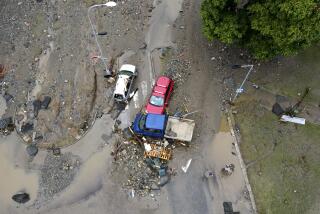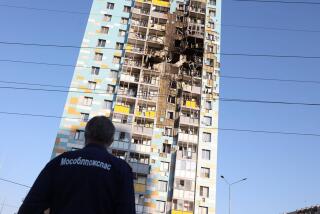The World - News from Aug. 4, 2002
- Share via
NIZHNY NOVGOROD, Russia — Maria Kulemina’s eyes were ringed red, her voice weary as she trudged down the main pedestrian boulevard of Russia’s third-largest city.
“We’re suffering a lot,” said Kulemina, 72. “Our eyes hurt and we’re losing our breath. It’s very, very hard.”
Her friend Antonina Danilova, also 72, pointed to a nearby building in downtown. “We live on the eighth floor,” she said, pointing to a nearby building, “and we can’t even see the top of the bank.”
Danilova was speaking about the effect of raging wildfires that have spread across Russia this summer, leaving behind the worst smoke clouds in 30 years. Thick, impenetrable blankets have settled over some of the largest cities, cutting off visibility, closing down airports and afflicting millions of people.
In the morning, the haze becomes so opaque it’s hard to make out the other side of the Volga River here in Nizhny Novgorod. In Moscow, the Kremlin and the famous cupolas of St. Basil’s Cathedral remain shrouded even from a modest distance. Airplanes circling over both cities Thursday had to pull out of their landing patterns and find other airports where pilots could see the runways.
Residents have adopted survival techniques, especially the elderly, parents with children and those suffering from asthma. Many are leaving town. Those who cannot are trying to block out the polluted air or restrict their movements.
“We don’t go outside in the morning,” said Lyubov Slavyanova, 66, who was caring for her 3-year-old grandson, Dima. “We close the windows. And for the night, we hang wet bedsheets. We go out only in early evening. That’s what the doctors told us -- don’t go out for a walk with the children during the day because it’s bad for them.”
Russia, one-ninth of the world’s land mass, seems constantly at war with some natural disaster or another. Floods in the south recently dislocated many residents. Severe cold in the far east during winter months regularly threatens whole cities left vulnerable by man-made energy shortages. Rivers in Siberia remain frozen so late into spring that they block currents and result in floods; on occasion, military jets are called in to bomb the ice and break it up.
Although emergency workers have successfully beaten back fires and prevented them from inflicting widespread destruction, they can do little to lift the veils of smoke choking Moscow, Nizhny and other cities. With little wind or rain, the smoke sits over crowded urban centers already enduring an unusually hot summer.
The heat wave and the exceptionally dry season have ushered in a wave of forest and peat bog fires unlike any seen since 1972. The Emergency Situations Ministry has recorded 21,764 blazes throughout the country this season, covering about 2.5 million acres. That would be the equivalent of half of New Jersey going up in flames. At the moment, about 250,000 acres remain on fire.
In Nizhny and around Moscow, the big problem is peat bog, a fuel-like terrain that smolders underground and sends smoke plumes into the air. Workers can soak it with water and try to cover it with sand, but putting out such fires altogether is exceptionally difficult.
“There is only one solution here -- a strong, constant rain that lasts a long time,” said Yuri Sentyurin, first deputy governor of Nizhny. “Otherwise, there’s no way to stop the smoking turf.”
Gen. Valery Korkodola, head of the local office of the Emergency Situations Ministry, said he has 1,600 firefighters, engineers and others working around-the-clock. “This whole situation is under control,” he said after returning from a tour of the worst area in the region. “The situation is getting better, not worse.”
Korkodola’s fire brigades managed to save a small village from annihilation a few days ago. As fire crept ever closer to Kerzhenets, nearly an hour’s drive from Nizhny, firefighters tried to stop it at the main road, only to have it leap across and ignite bales of hay. Rescue workers decided to evacuate the village of small, ramshackle wooden houses.
To save Kerzhenets, firefighters, joined by local residents and a group of 10-year-old boys given backpacks filled with water and spouts to spray, battled the blaze for hours until they got it under control.
More to Read
Sign up for Essential California
The most important California stories and recommendations in your inbox every morning.
You may occasionally receive promotional content from the Los Angeles Times.










